Muntham Court Romano-British site
The Muntham Court Romano-British site is an archeological site situated on the western edge of the village of Findon in West Sussex.[1] It is a Scheduled Ancient Monument that includes Iron Age and Romano-British settlement.[2]
| Muntham Court Romano-British site | |
|---|---|
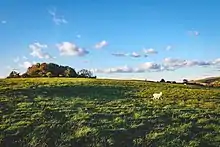 View of the site from south-eastern side, overlooking approximate location of the settlements | |
| Location | Findon |
| Coordinates | 50°52′22″N 0°25′23″W |
| OS grid reference | TQ 11105 09314 |
| Official name | Muntham Court Romano-British site |
| Reference no. | 1005850 |
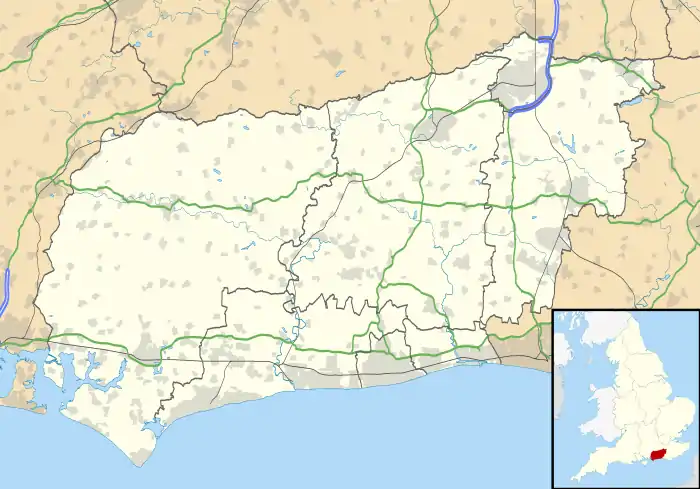 Location of Muntham Court Romano-British site in West Sussex | |
Description
The site was excavated in the 1950s by Mr. G.P. Burstow and Mr. G.A. Holleyman at a cost of about £50 (equivalent to £264 in 2019) with equipment borrowed from Brighton College (Junior School).[3] It revealed an extensive late Iron Age and Romano-British settlement including housing structures, trackways, field boundaries as well as a temple or a shrine. A 76.2 metres (250 ft) deep well can be found in the adjacent field to the south.[4]
Iron Age Settlement
The late Iron Age settlement is located at the top of the hill and includes several hundred post holes marking probable locations of huts and corn drying racks. A storage pit can also be found. The settlement was partially enclosed by a palisade with a shallow ditch marking an eastern edge of the site, it survives as a buried feature. Finds from the site include fragment of a Bronze Age perforated macehead, Iron Age pottery as well as spindle whorls and loom weights.[2]
Roman temple
The Romano-British temple is located at the summit of the hill and can be seen as earthwork marked by a circular depression 11 metres (36 ft) in diameter. The shrine itself was constructed from wood rather than stone[5] and consisted of two structures, one square and the other trapezoidal, both marked by post-holes.[6] A copper alloy plaque of a boar from the site may have been associated with a Roman temple at Chanctonbury Ring.[7] It is now located at Worthing Museum and Art Gallery alongside other artefacts from the site, including a 2nd century enamelled fish brooch and a 3rd century musical instrument mouthpiece.[8]
Archeological finds
A number of archeological finds from the site are held at the Worthing Museum (both on display as well as in storage).[8] This list presents notable finds in alphabetical order.
| Item | Description | Date | Material | Location | Image |
|---|---|---|---|---|---|
| Bill hook[9] | An iron hook used for cutting plants. | 1st - 4th century AD | Iron | Worthing Museum | |
| Boar plaque[7][8] | A small copper plaque of a charging boar (100 millimetres (3.9 in) by 40 millimetres (1.6 in)). | 1st - 4th century AD | Copper alloy | Worthing Museum |  |
| Bones and shells[10] | Animal bone and oyster shell fragments | 1st - 4th century AD | Bone and shell | Worthing Museum | |
| Enamelled fish brooch[11][8] | A brooch in the shape of a fish with blue, red and green enamel 30 millimetres (1.2 in) long. | 2nd century AD | Copper alloy Enamel | Worthing Museum |  |
| Model leg[12] | A crude model of human leg. | Clay | Worthing Museum |  | |
| Musical instrument mouthpiece[8] | A metal mouthpiece for a musical instrument. | 3rd century AD | Worthing Museum | ||
| Needle and hairpin[13] | Bone needle and a bone hairpin, 85 millimetres (3.3 in) and 50 millimetres (2.0 in) long respectively. | 1st - 4th century AD | Bone | Worthing Museum |   |
| Penannular brooch[14] | Small metal broach, 26 millimetres (1.0 in) diameter. | 1st - 2nd century AD | Copper alloy | Worthing Museum | 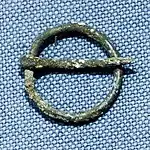 |
| Saw blade[15] | A saw blade fragment, 60 millimetres (2.4 in) long. | 1st - 4th century AD | Iron | Worthing Museum | |
| Sceptre pommel[16] | A hollow object 105 millimetres (4.1 in) long that may have served as a pommel for a sceptre. | 1st - 4th century AD | Copper alloy | Worthing Museum | |
| Shield boss[17] | Copper shield boss perforated at the corners | 1st - 4th century AD | Copper alloy | Worthing Museum | 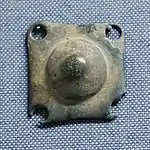 |
| Stud[18] | Ornamented stud 23 millimetres (0.91 in) diameter. | 1st - 4th century AD | Copper alloy | Worthing Museum | 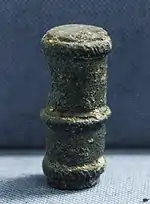 |
| Wire tongs[19] | Thin wire tongs 100 millimetres (3.9 in) long when bent. | 1st - 4th century AD | Copper alloy | Worthing Museum |  |
References
- https://mapservices.historicengland.org.uk/printwebservicehle/StatutoryPrint.svc/5886/HLE_A4L_NoGrade%7CHLE_A3L_NoGrade.pdf
- "Muntham Court Romano-British site, Findon - 1005850 | Historic England". historicengland.org.uk. Retrieved 23 September 2020.
- https://www.worthingarchaeological.org/uploads/8/6/3/9/86390614/was_the_first_60_years_by_daphne_palmer.pdf
- https://www.findonvillage.org/uploads/The%20Archaeology%20of%20the%20Parish%20of%20Findon.pdf
- "Pagan Saxon Place Names In Sussex". sussexarch.org.uk.
- https://historicengland.org.uk/images-books/publications/iha-later-prehist-shrines-ritual-structures/heag207-later-prehistoric-shrines-and-ritual-structures/
- "Romans in Sussex - Level 3 Search - Home Page". August 23, 2007. Archived from the original on 2007-08-23.
- "Archaeology Collection". wtam.uk. Retrieved 24 September 2020.
- "Bill Hook". 14 May 2003. Archived from the original on 2003-05-14. Retrieved 24 September 2020.
- "Bones & Shells". 15 May 2003. Archived from the original on 2003-05-15. Retrieved 24 September 2020.
- "Fish Brooch". 15 May 2003. Archived from the original on 2003-05-15. Retrieved 24 September 2020.
- Worthing Museum and Art Gallery. "Muntham Court". Worthing, West Sussex, 2020. Plaque
- "Needle & Hairpin". 15 May 2003. Archived from the original on 2003-05-15. Retrieved 24 September 2020.
- "Penannular Brooch". 15 May 2003. Archived from the original on 2003-05-15. Retrieved 24 September 2020.
- "Saw Blade". 15 May 2003. Archived from the original on 2003-05-15. Retrieved 24 September 2020.
- "Sceptre Pommel". 14 May 2003. Archived from the original on 2003-05-15. Retrieved 24 September 2020.
- "Shield Boss". 15 May 2003. Archived from the original on 2003-05-15. Retrieved 24 September 2020.
- "Stud". 14 May 2003. Archived from the original on 2003-05-14. Retrieved 24 September 2020.
- "Wire Tongs". 15 May 2003. Archived from the original on 2003-05-15. Retrieved 24 September 2020.